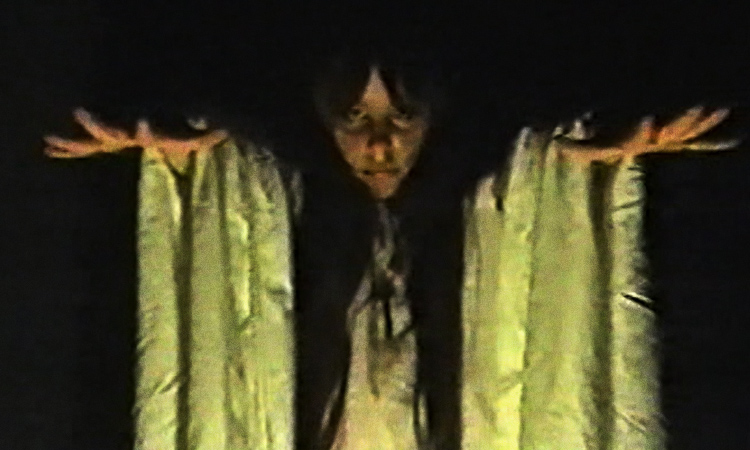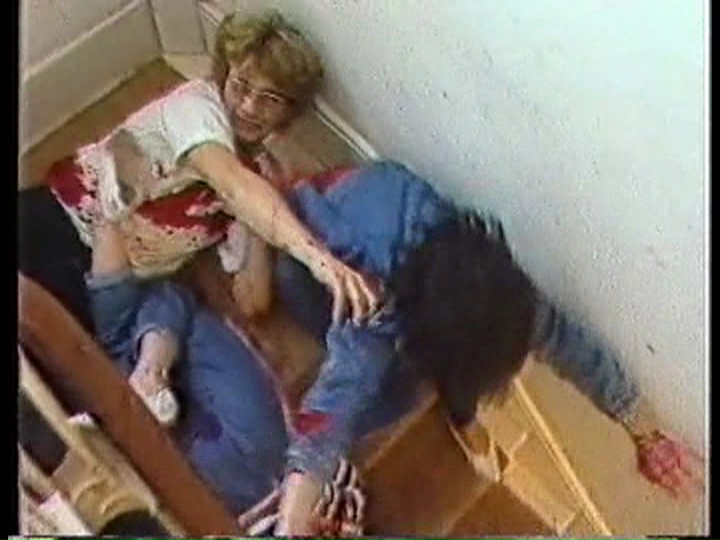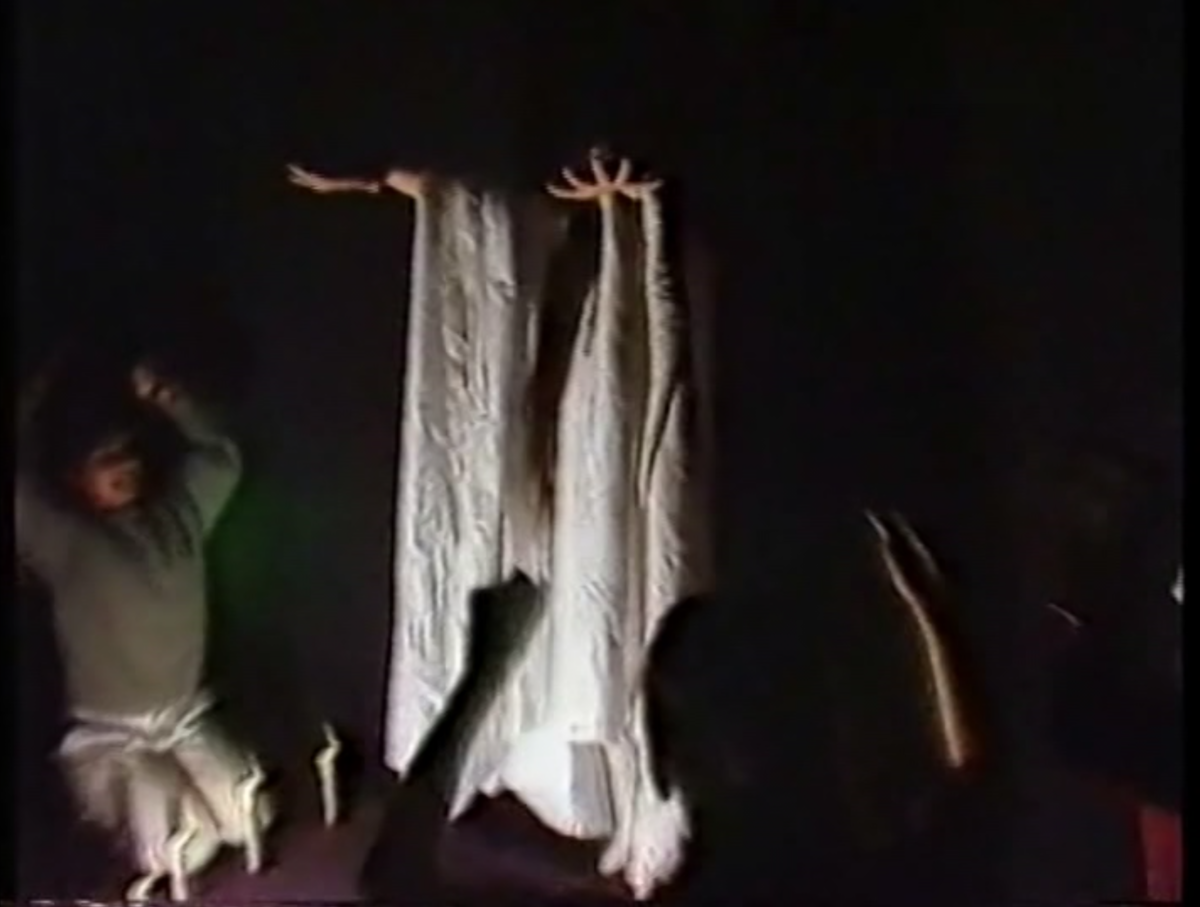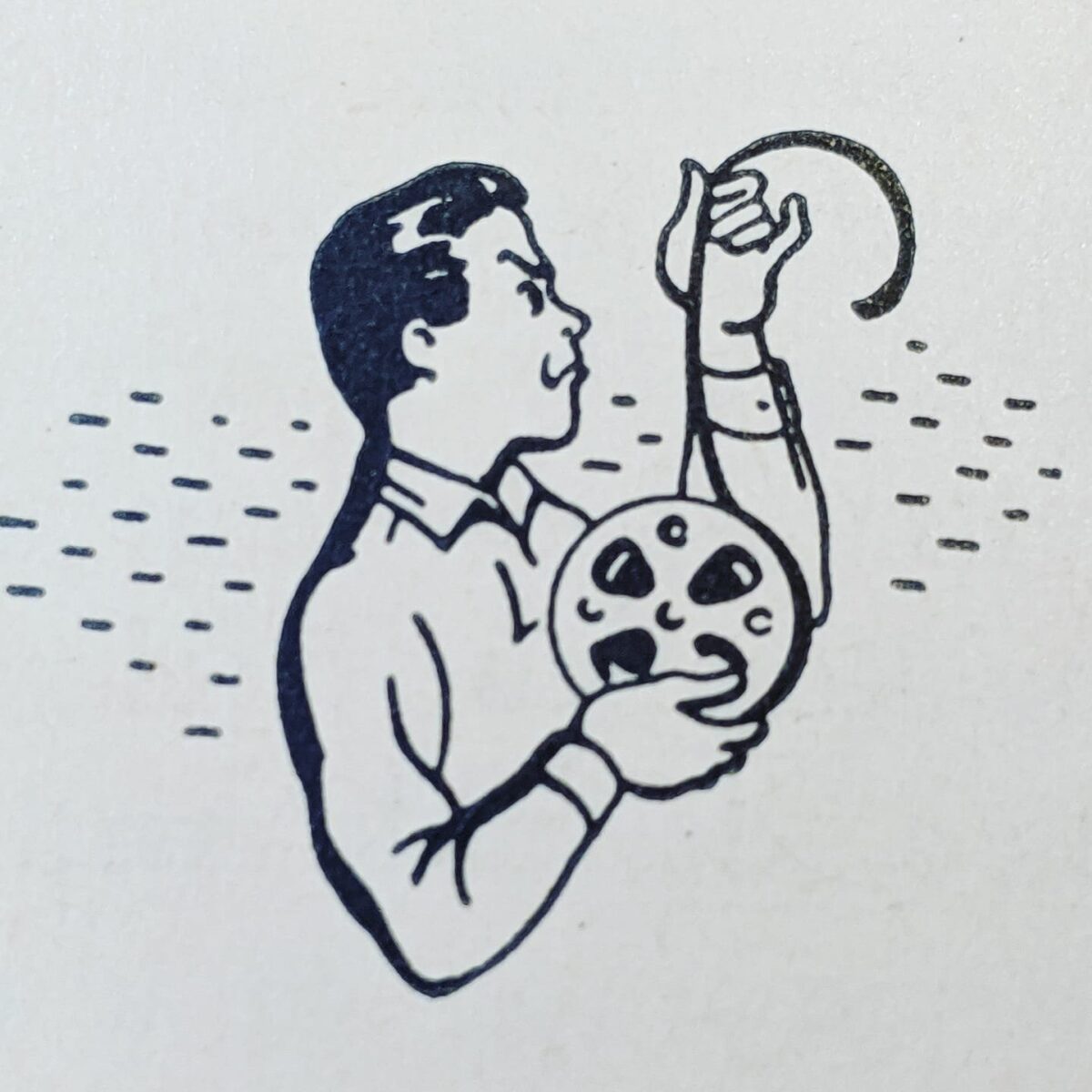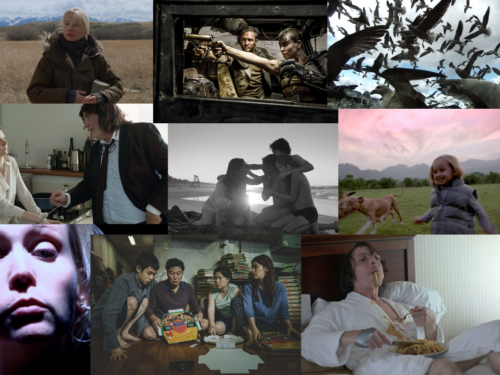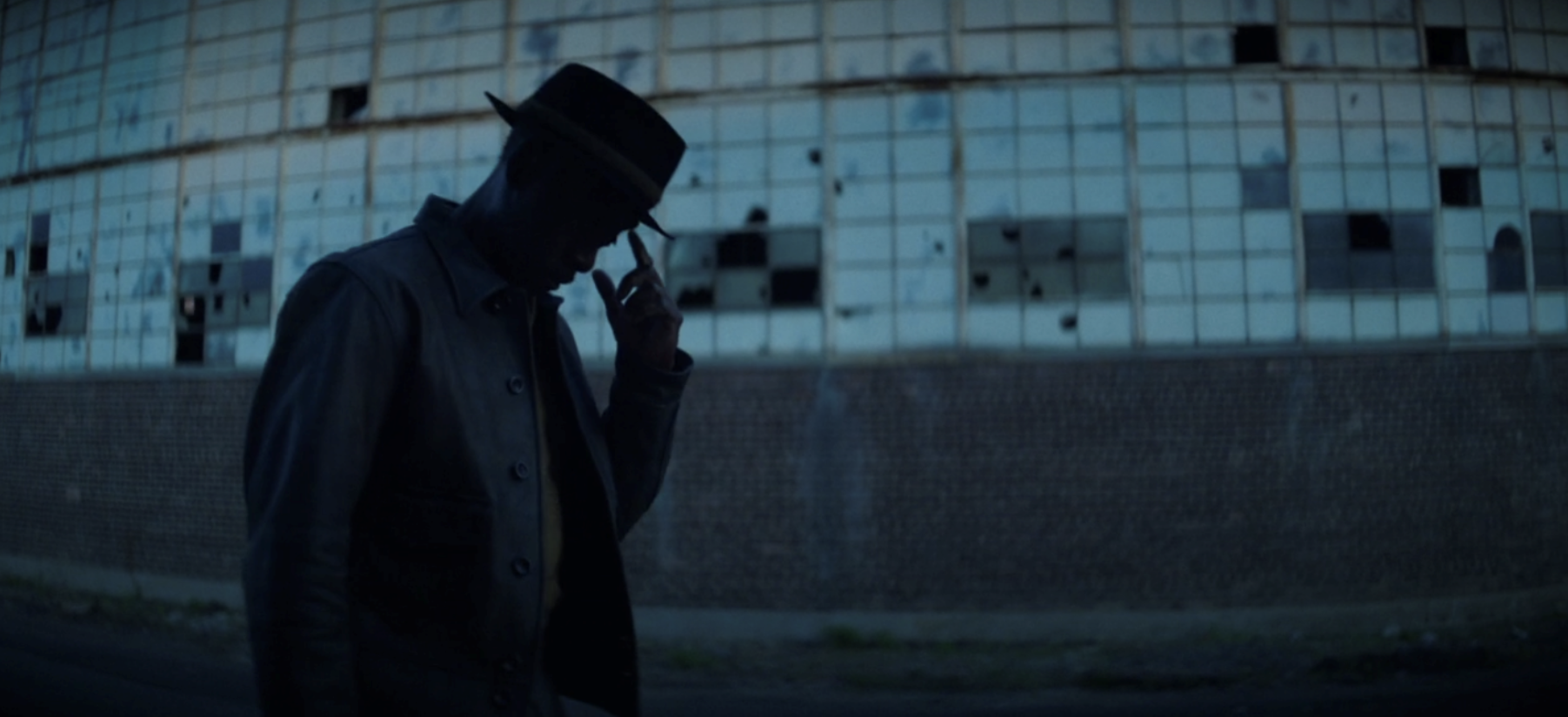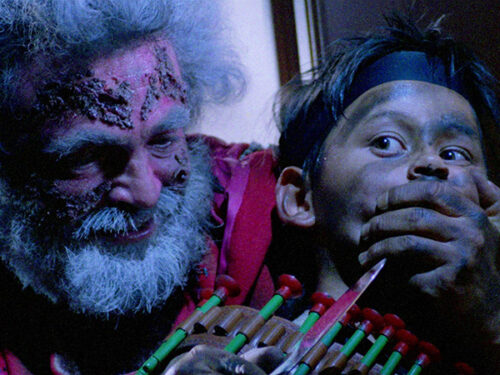Produced by an intergenerational drama school in South London, Suffer Little Children bears out the transcendent possibilities of the imagination of children
Elizabeth (Nicola Diana), a young girl who cannot speak or write, is left at the doorstep of the Sullivans Children’s Home with a note that advises that “this is the right place for her.” The social workers who run the home — socially inept, sarcastic Maurice (Colin Chamberlain) and sweet, passionate Jenny (Ginny Rose) — attempt to understand why she was abandoned to them. Upon her arrival, the community of children already present in the home begin to run afoul of violent, supernatural forces willed by Elizabeth, who manipulates and terrorizes her housemates and caretakers. Visiting pop star Mick Phillips (Jon Hollanz), a former resident of the home, has returned while on a press junket. By the end of this ordeal, interlopers Mick and Elizabeth will become incarnates of good and evil in the moldering ruins of the home.
Suffer Little Children (1983) was made by the Meg Shanks Drama School in South London, with a cast of intergenerational theater students. Shanks is credited as screenwriter and local talent promoter Alan Briggs as director, but there are indications that Shanks and Briggs were simply conductors of the students’ improvisations, that the film is a semi-coherent assembly of scene studies threaded together by a horror story. Suffer Little Children might best be described as a record of children-at-play. The Japanese poet-priest Kobayashi Issa offers this haiku: “children imitating cormorants / are even more wonderful / than cormorants.” In other words, the naivety of a child’s mimicry is a primal encounter with the soul of creativity. Suffer Little Children bears out something like Issa’s praise: the transcendent possibilities of the imagination of children, cawing and barking, internalizing the poetry of the world around them, playing and playing dead, rolling the stone away. The film’s gruesome fantasy and smirking vulgarity plays out in scenes from that secret world of children, where the young are socialized through forbidden expression — eavesdropping on the adult world, or initiating each other through the handed-down knowledge of older siblings. Children learn about adulthood through play and fantasy, but they also learn repression, and the joy of transgression, by the threats of authority. In Suffer Little Children, even scenes in which characters converse feel like stray, half-heard discussions remembered from childhood, the soundscape of a world vast in perception and narrowing in fascination.
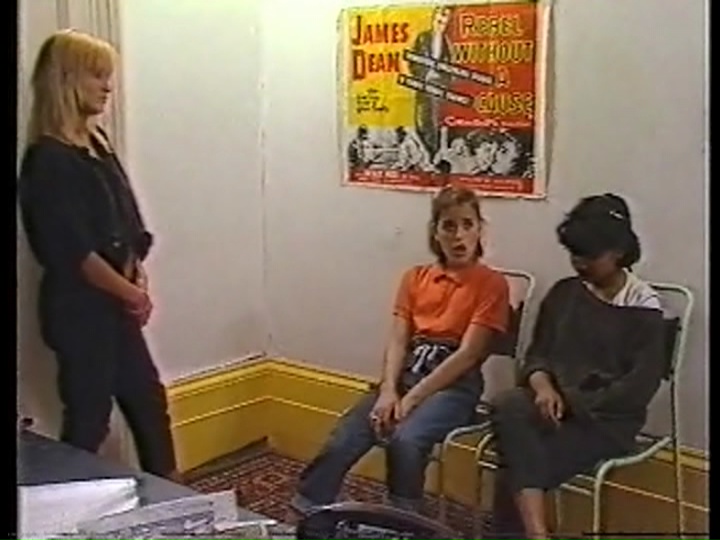
Made on consumer video equipment, Suffer Little Children shifts between two modalities: It begins with pretenses to docudrama, with on-screen dates and intertitles that promise a dramatization of terrible events that have occurred at the children’s home; it soon abandons this docudrama form in favor of a more conventional horror progression, interspersing the world of its mischievous children with the concerns of well-intentioned but puzzled adults. Despite the theatrical roots of its ensemble, it is riddled with the tropes of genre filmmaking, in particular, intercutting. The film integrates shots of Elizabeth’s face into scenes which do not feature her, suggesting the all-seeing telepathic energy that she will gradually unleash on the cast. With these acts of intercutting, Elizabeth is an intruder. But she is more than the symbolic intruder of the story — she becomes an intruder into the movie itself.
The amateur roots of Suffer Little Children inform its construction. Dialogue is often incomprehensible; the music drowns it. This amateurism makes the film more authentic as “play,” as it doesn’t suffer the sham of technological mastery in pursuit of a suspension of disbelief. The speed and joy of its making is borne out in muddled speech and half-composed shots. This authenticity is mirrored in the film’s celebration of the taboo world of children. Such authenticity is evident in the party sequence in which the children dance to the menacing anthem that gives the film its title, a song dominated by occult, spoke-sung threats. The film endorses fear as an element in the fun of children. Likewise, in the end credits, when the filmmakers acknowledge a litany of scary, adult movies — Carrie, Psycho, Halloween, and Mad Max — this too is an admission of the precocious fact of childhood, and the child’s ability to absorb and perform, and at the same time, withstand, adult fears. Imaginary ghouls travel hand-in-hand with children. They journeyed out of the Aesopica to impart lessons. But in the twentieth century their plastic monster-mask presence could signify both fearlessness and an elusive sense of belonging, felt in the outcast manors of The Addams Family and The Munsters. The monstrous, in the imagination of the child, can also be a mirror to one’s own outcast sensibility. To see, understand and regard with empathy a story like that of Carrie or Psycho, is to understand the cruelties dealt by trauma — traumas children inevitably know well, first- or second-hand such as bullying and abuse. The amateurism of Suffer Little Children, in its mimicry of the dark side of entertainment, is bound to themes of fellowship and trauma.
When they first meet, Mick gives Elizabeth his crucifix. This symbol of suffering is also a symbol of fellowship, and in a chilling irony, it seems to amplify Elizabeth’s power. She begins to enlist other children into her cabal, drawing them into a common dream where they picnic with zombies. This is the first stage of the predestined convergence between Mick and Elizabeth: Good and Evil, Christ and Antichrist. Their eventual confrontation is foreshadowed with a bizarre sequence in which Elizabeth seems to conduct a black mass that corresponds with a visit by Mick and Jenny to a new wave club: the social realism of the club atmosphere, most of it cloaked in darkness and vaguely erotic, is intercut with Elizabeth’s menacing yet cherubic, red-lit face. The symbolic order of good and evil is utterly confused: Dionysian rituals of British post-punk youth become apostolic — and the children imitating cormorants are even more wonderful than cormorants.
Much of Suffer Little Children is a slow-burn psychological horror movie. The laconic pace of its scenes allow the dim ebb and low resolution of video to hide menace in every corner. But it is only on rare occasions that the story erupts into outright violence. When it does, that violence is of the Grand Guignol style, as when a child falls down the stairs and spits up gore and unnatural streams of blood. Likewise, when Maurice is stabbed in the hand by a hypnotized ward, blood gushes from the wound. When at last Elizabeth’s supernatural forces overwhelm the house and its residents, there comes an orgy of mutilation and self-mutilation, commencing with floating furniture and plants, doors held shut by a combination of light touch and psychic seal. The inanimate is given power, like a carving of Christ on the cross. A teenager acting under hypnosis stabs herself repeatedly, the wound spurting blood; Mick’s manager and Maurice, attempting a rescue, are brutally stabbed, and even their corpses are mutilated. The graying white walls of the house’s stairwell are splattered with flecks of stage blood. All the while, the zoom lens of the video camera crashes in and out of Elizabeth, in a white robe leading a black mass, in itself both a hypnotic gesture and a symbol of hypnotism.
When Mick confronts Elizabeth, he is crucified. With a flash, both are transformed. She is transformed into an adult — confirmation that her child body was just a shell the whole time — while he is transformed into Jesus Christ. In this gesture, the amateur movie is transformed as well, into a work of subconscious, vernacular surrealism. What follows is something akin to the Harrowing of Hell, but this Christ isn’t saving souls: he fights his tormentors, collaborating with the video camera to make them shake and shudder and finally, in an ugly triumph, elicits an immense scream from mute Elizabeth. Children imitating cormorants are even more wonderful than cormorants. The Shanks Drama School players are synthesizing all of the codes they’ve learned from movies and elsewhere — the Passion Play by way of Carrie White. But the way in which they are using video effects, including vibrating elliptical edits that make the image feel as if it is shuttling violently into oblivion, suggest something new; something of their own time, or something, at least, that they would not encounter in mass culture’s past, like so many of their sources. It is an aesthetic of contemporaneous mass culture, of the vanguard of the music video. Suffer Little Children begins with claims of evidence, documentation, re-enactment. It is backwards-facing like their influences, but it ends with that most impossible of images: a photograph of Jesus Christ.
In the end credits, the children are thanked for their “guts and determination.” Suffer Little Children is, like so much of the popular culture around its creators, both rebellious and conformist. It’s a riff on commercial culture that celebrates an anti-authoritarian posture, summed up in the title song when the singer commands, “suffer you bastards!” What does it mean to be anti-authoritarian and to make a religious horror movie in which God, the highest authority, is the protagonist? The haiku of Issa gives us permission to see that this doesn’t have to mean anything: that imitation, mimesis, synthesis, play, is meaningful in itself.
Purchase Suffer Little Children on DVD from Amazon or Severin Films
Stream Suffer Little Children on Amazon Prime
Explore Stephen Broomer’s Art & Trash website for his video essays
Broomer is also the founder of Black Zero, a home video label that specializes in Canadian underground film. Explore its collection of films at blackzero.ca
Find the complete October Horror 2023 series here:
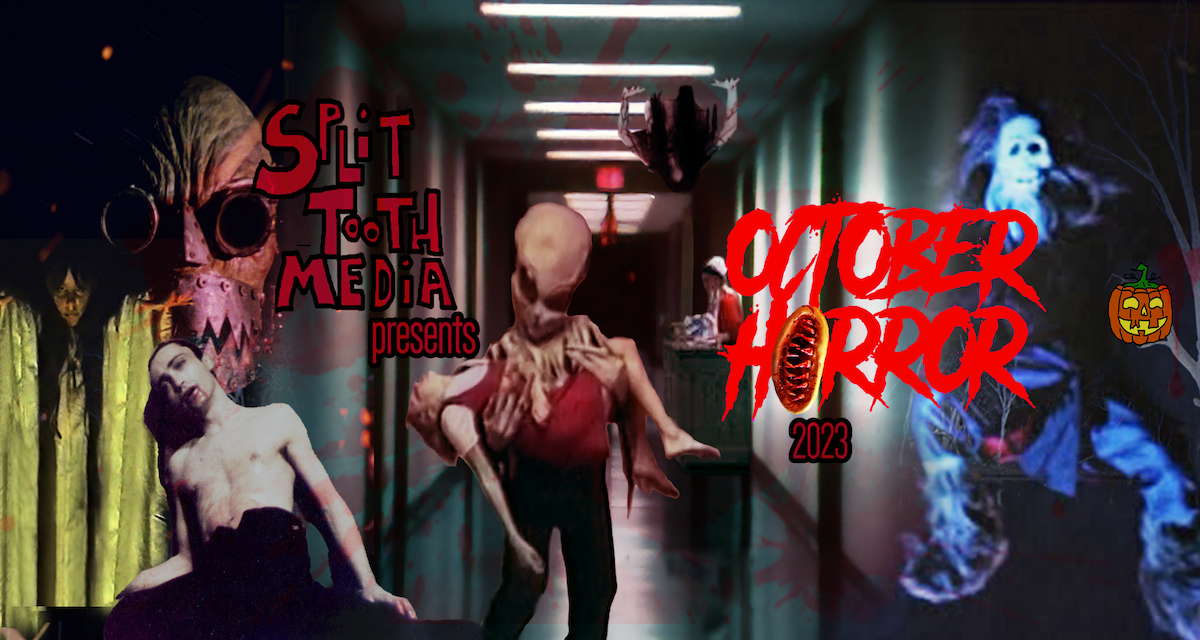
(Split Tooth may earn a commission from purchases made through affiliate links on our site.)

